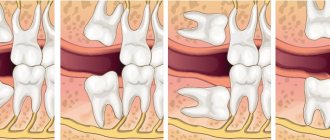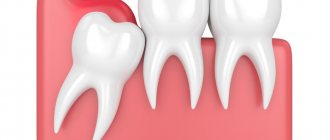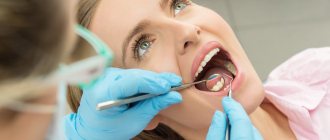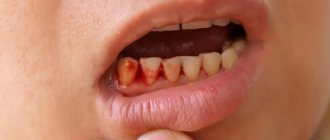A wisdom tooth is the third molar, which appears later than the others, and sometimes does not erupt at all. A person cannot have more than 4 wisdom teeth. The approximate time when teething begins is 18 - 27 years.
Modern experts classify wisdom teeth as rudiments - elements that, in the course of evolution, have lost their role for humans. The specific location of third molars causes a number of difficulties in terms of caring for them.
“Eights” are not loaded like other teeth. In addition, they almost always tend to erupt painfully. It is not surprising that they are called the most problematic, and most dentists recommend removing wisdom teeth at the first opportunity.
Why does wisdom tooth hurt?
Wisdom teeth almost always grow crooked. Problems with teething are dictated by the following anatomical features:
- “Eights” appear later than all other teeth. As a rule, the jaw bones are fully formed, the dentition is stable, and the “newbie” simply does not have enough space;
- The third molars do not have milk “predecessors”, and the rudiments of wisdom teeth developed for too long and not in very favorable conditions. Because of this, they erupt chaotically, damaging the adjacent tooth or causing inflammation of the gums.
When talking about the causes of pain associated with one or more molars, it is worth distinguishing between some concepts. Toothache can occur against the background of abnormal eruption, due to deformations of soft tissues of neighboring teeth. This clinical picture is typical only for “eights”; other teeth are cut much more smoothly.
Causes
However, the cause of toothache may also lie in fairly classic causes associated with common dental pathologies: caries, periodontal disease or periodontitis. If you systematize all the reasons that cause tooth pain, you will get the following list:
- The wisdom tooth rests too much on the tissues of the oral cavity, squeezing and injuring them;
- The tooth is rotated around its axis. The greater the angle of rotation, the more tense the dental nerve is, which provokes pain;
- Carious cavities have formed on the surface of the wisdom teeth; if they reach the dental tissues, the pain will intensify;
- Tartar deposits have formed, which rub the gums and cause inflammation;
- Due to the fact that the rapid growth of the “eight” and crooked eruption damaged the root system of the neighboring molar, it is this neighboring tooth that hurts;
- If the wisdom tooth, due to its incorrect position, begins to pinch the jaw nerve, pain occurs in the lower jaw. In this case, neuritis manifests itself in this way;
- A follicular cyst has formed at the neck of the tooth. It often occurs against the background of permanent damage to the gum tissue and the tooth itself.
It is worth noting the fact that a follicular cyst near wisdom teeth is often accompanied by all sorts of complications. For example, an abscess may occur that can even deform the jaw in a neglected state. The periodontal tissues may also become inflamed and pericoronitis may develop.
Inflammatory processes of the tissue covering the wisdom tooth
Inflammation of the hood is a common phenomenon. If a wisdom tooth erupts through several crown cusps at once, phenomena may occur when the chewing surface of the crown is partially covered by tissue. The part of the gum and mucous membrane that overhangs the molar and is called the hood. He is constantly susceptible to injury and prone to inflammation.
Under the surface of the hood, particularly favorable conditions arise for the accumulation of various biological “garbage” and the proliferation of pathogenic bacteria. Often even the slightest damage causes irritation. The gums around the “eight” may not hurt much, so they don’t always turn to people with such a problem.
However, if the inflammatory process is severe, the tissues not only swell, but are also irritated. The patient complains of painful swallowing, sometimes it is difficult even to simply open his mouth. There may be pus and severe hyperemia on the gum near the wisdom tooth. Only a doctor can save you from such an obsessive and severe dental inflammation by excision of the hood.
Lack of space during teething
If there is not enough space for the wisdom tooth in the dentition, neighboring tissues are injured during eruption. The pain is total. It hurts not only the place where the molar erupts, but also the neighboring teeth. Swelling, hyperemia, and severe pain that are permanent may also be observed. It is difficult for the patient to open his mouth, especially if the “eights” grow in the direction opposite to the jaw. Such teeth must be removed. This is due to the fact that a crooked tooth can damage the entire dentition, up to its noticeable curvature.
Caries
If a wisdom tooth is affected by caries, the first symptom indicating the disease will be pathological increased sensitivity of the teeth. They will react painfully to any irritants - sour, spicy, salty foods, sweets, cold irritants.
Situations often occur when the curvature of a wisdom tooth injures the neighboring tooth, which causes caries in it. The most dangerous situation is when the “eight” damages the root of the neighboring “seven”. Caries develops just below the gum, and the doctor is not always able to visually identify the carious lesion. At the same time, a severely advanced form of “root” caries is difficult to treat and the tooth can almost never be saved.
Pulpitis
In acute pulpitis that affects the wisdom tooth, patients complain of acute pain that occurs in attacks. The disease and its main manifestations are characterized by a spontaneous nature. Unpleasant sensations can occur spontaneously and last up to 15 - 30 minutes. At night the pain intensifies.
In the chronic form of wisdom tooth pulpitis, the pain is not so pronounced. Unpleasant, aching sensations occur against the background of exposure to cold or heat. If the irritant is removed, the pain continues for some time.
Periodontitis
Periodontitis is characterized by aching pain that constantly worries the patient. At the same time, the diseased tooth will react to any irritant with acute pulsating, shooting pain. Slight mobility of the affected tooth is also noted, and swelling and soreness of the gums are often observed.
It is interesting that with chronic periodontitis the pain is almost not disturbing. Very minor unpleasant sensations can only appear when the “figure eight” is tapped on the patient’s tissues.
Stages of caries
There are 4 stages of carious lesions, each of which differs in the number and intensity of symptoms. The first (initial) stage is called the chalky (or white) stain stage, in which an area of demineralization forms on the tooth surface. Outwardly, it looks like a white speck, lacking shine. Under a microscope, you can see that in this area the enamel is rough, loose and porous. However, there is no carious cavity yet, so it is possible to cure the tooth without filling. The person is not bothered by any symptoms. Caries can be detected at the initial stage only during an examination.
At the second (superficial) stage, the carious process penetrates into the deep layers of the enamel, but remains within its limits, without spreading to the dentin. The white spot darkens and becomes brownish. The pathology can already be noticed independently if it develops on the outside of the tooth or fissures. Complaints appear: tooth sensitivity to sweets increases, sometimes to hot and cold, and there is discomfort when chewing food. However, it disappears as soon as the irritating factor is eliminated.
The third (middle) stage of caries is characterized by the penetration of the carious process into dentin. A brown or dark yellow cavity is formed, which is easy to see with the naked eye. Discomfort while eating is an almost constant concern, especially when a diseased tooth interacts with sour or sweet foods. The sensitivity of dental tissues to temperature changes also increases. The pulp is not yet involved in the pathological process, but this stage of caries can already be considered complex. At this stage it will not be possible to avoid preparation and filling. There is a risk of complications, possibly inflammation of the lymph nodes.
The fourth (deep) stage of caries is considered an advanced form of the disease, in which the carious cavity covers almost half of the tooth. It usually looks like a black hole with sharp edges. Pain occurs not only when eating, brushing teeth or temperature changes, but also at rest. The likelihood that caries will spread to nerve tissue and cause pulpitis is quite high. Moreover, the tooth may break into several parts, resulting in the need to remove it. This happens in cases where there is no treatment for the disease.
You can cure caries and save your tooth at any stage. But its loss is not the only complication of the carious process. There is a risk of developing other pathologies that are not dental.
Diagnostics
Any pathology associated with the problematic eruption of one or more wisdom teeth should always be investigated through x-ray diagnostics. To determine the position of the tooth in the jaw (inclination, shape, configuration, structure, how it grows), an orthopantomogram is used.
OPTG is a high-quality panoramic image of all teeth on both jaws. Another diagnostic method that will help you understand why your wisdom tooth hurts is visiography.
Other causes of inflammation of the submandibular lymph nodes
The lymph node is an important component of the entire lymphatic system, which performs many different functions. It is involved in maintaining immunity, protects against pathogenic microorganisms, transports nutrients, and removes harmful components from the body, for example, dead red blood cells and bacteria. Lymph nodes respond to many changes that occur in the human body. Almost any pathology or its complications can provoke lymphadenitis. We list the common causes of inflammation of the lymph nodes:
- Infectious diseases: chronic tonsillitis and tonsillitis, otitis, sinusitis, mumps, alveolitis, streptococcal infections.
- Pathologies that strongly affect the state of the immune system: lupus, HIV and AIDS, leukemia, arthritis, tuberculosis.
- Toxoplasmosis is a parasitic disease that often occurs in a chronic form and is accompanied by symptoms such as low-grade fever, swollen lymph nodes, decreased performance due to fatigue, headache, etc.
- Diseases that usually occur in childhood: chickenpox, measles, mumps. They affect the state of the entire lymphatic system.
- Tumors. If the lymph node is inflamed, but the person does not notice any other symptoms, has not been injured and does not suffer from chronic diseases, then it is necessary to undergo a systemic examination. Lymphadenitis can be the initial symptom of oncology.
If your lymph node is inflamed, do not try to eliminate the inflammation using folk remedies. Thus, the inflammatory process may be a consequence of the development of a bacterial infection, which must be treated with antibiotics. Many people apply cold or, on the contrary, hot lotions to the swollen area, and this causes even more active growth of bacteria. As a result, complications may develop. There are many causes of lymphadenitis, so deciding on self-treatment is dangerous.
Treatment methods
Experts practice removal of wisdom teeth in case of carious lesions or in cases where extremely problematic eruption is observed for people of any age. Pain and inflammation indicate a serious problem. If it is not resolved in a timely manner, complications cannot be avoided.
Easy removal
The doctor decides what to do in each specific situation based on the research results obtained. This can be either a simple removal or a rather complex multi-stage operation.
Before the procedure, the specialist must make sure that the patient is not allergic to the medications that will be used during the procedures. First, the soft tissue around the tooth and the nerves are numbed. After the anesthesia has taken effect, the tooth is removed using forceps. The duration of the entire procedure does not exceed 10 minutes.
Difficult removal
If the crown of a tooth is destroyed, it has large branched roots, and also if the “eight” has not erupted at all, and the entire jaw is involved in the inflammatory process, complex removal is practiced. During the intervention, the dental surgeon makes one or more incisions, removes the tooth, washes the wound surface, and then applies sutures.
It is also worth mentioning the procedure for excision of the hood. If it is the wisdom tooth that hurts at the time of eruption due to inflammatory processes of the mucous membrane, the doctor removes fragments of “excess” tissue. There may be situations when the wisdom tooth is not removed, but only soft tissue correction is performed. This is true if the tooth itself does not hurt and is located correctly in the socket.
Purulent tooth abscess and lymph nodes
A tooth abscess is a purulent inflammation that is localized inside the tooth after pulp removal, in the periodontal area or under the gum. This pathology is characterized by shooting, throbbing pains that intensify with pressure and heat on the tooth. Inflammation of the lymph nodes under the jaw is possible, which is sometimes even noticeable from the outside: the patient develops a slight swelling in the neck. In rare cases, the abscess spreads to the bone tissue and causes swelling on the face. Some complain of migraines. The disease is complicated by the presence of other dental diseases, such as caries.
The main directions of treatment of submandibular lymphadenitis
The direction of treatment is determined by the etiology of the inflammatory process. If the disease is infectious, antibiotics, antifungal and anti-inflammatory drugs, sprays and ointments are prescribed. Purulent inflammations are treated promptly under local anesthesia. The doctor cleans the lymph node of purulent masses and installs drainage. After this, the patient is prescribed appropriate medications.
Often, after eliminating the underlying pathology that led to inflammation of the lymph nodes, all its symptoms, including lymphadenitis, disappear. If this does not happen, the patient undergoes a course of physical therapy. Immune-boosting therapy may be needed. The patient needs to stop smoking, start eating right and taking vitamins.
Treatment of submandibular lymphadenitis with caries
Caries is treated with various methods depending on the stage. At the first stage, in which you only need to eliminate the white spot, remineralization of the tooth surface is carried out. With the help of special preparations, the enamel is saturated with minerals - calcium and fluorine. Therapy is prescribed in a course lasting 5-15 procedures. For home use, the patient is prescribed hygiene products that help restore enamel and the balance of microelements in the oral fluid. Such means include:
- toothpastes: Marvis Orange Blossom Bloom, Dentissimo Complete care, Apadent Perio;
- gels: Stomysens® Desensitizing Repairing Treatment 4, DRC ROCS (ROCS) Medical Minerals, Dental Resources Inc Sorbet Revive;
- rinses: Vivax “Remineralization”, CURAPROX Perio Plus Forte chx 0.20%, Biorepair Delicate Gums Mouthwash.
If a carious cavity has formed on a tooth, then remineralization will not help; filling is necessary. First, the dentist cleans the hole from necrotic tissue and food debris, after which he places a protective gasket and fills the cavity with filling material. If caries is complicated by pulpitis, the nerve has to be removed.
After treatment of the carious process, the inflamed lymph node should return to normal. If this does not happen, it is necessary to re-diagnose. Perhaps the inflammation is not a consequence of caries, but of another disease.
More often, the submandibular lymph nodes become inflamed during the chronic course of the carious process, in which slow tooth destruction is observed. It is not accompanied by severe symptoms, but with exacerbations or the presence of certain factors, inflammation of the lymph nodes occurs.











